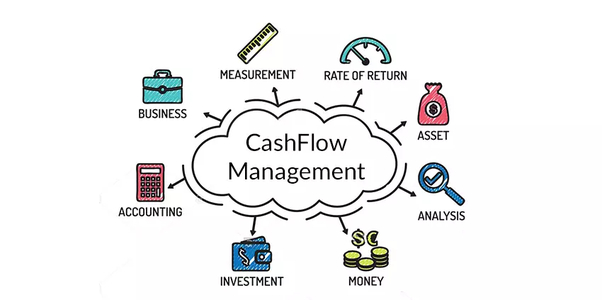Cash flow refers to the movement of money in and out of a business. It’s the amount of money coming into the company from sales, investments, or other sources, minus the amount leaving the business through expenses like rent, salaries, and loan payments. In simple terms, it’s the net amount of cash generated by or used in a business during a specific period.
Cash flow is vital for a business’s survival and growth. It shows the company’s ability to meet its financial obligations, like paying bills and employees, on time. Positive cash flow means a business can cover its expenses, reinvest in operations, and weather unexpected challenges. Conversely, negative cash flow can lead to serious problems, like missed payments and potential bankruptcy. Understanding cash flow including business checks helps businesses make informed decisions about spending, investments, and expansion.
Table of Contents
Components of Cash Flow
These components help businesses assess their sources of cash and how they are being used. A thorough analysis of cash flow activities enables management to make strategic decisions, such as adjusting operating expenses and investing in new opportunities.
Operating Activities
Operating activities are the day-to-day transactions that directly impact cash flow. This includes the cash received from customers when products or services are sold. It also includes cash paid for operating expenses, such as rent, salaries, utilities, and raw materials. Think of it as the cash flow from the core operations of the business.
When a business sells more than it spends on operating expenses, it generates positive cash flow from operating activities. This positive cash flow is crucial because it shows that the business is making money from its main operations, which is essential for its sustainability and growth.
Investing Activities
Investing activities involve the cash flows related to buying or selling long-term assets. This includes purchasing new equipment, machinery, vehicles, or property. When a business invests in these assets, it usually spends cash, resulting in a negative cash flow from investing activities.
However, when the business sells these assets, it receives cash, leading to a positive cash flow. Monitoring cash flow from investing activities helps businesses understand how much they are investing in growth and whether these investments are yielding returns. It’s like looking at the big purchases a business makes to expand or improve its operations.
Financing Activities
Financing activities relate to how a business raises and pays back money to fund its operations and growth. This includes borrowing money through loans or issuing bonds, as well as paying back these debts. When a business takes out a loan, it receives cash, resulting in a positive cash flow from financing activities.
Conversely, when it repays a loan or pays dividends to shareholders, cash leaves the business, leading to a negative cash flow. Monitoring cash flow from financing activities helps businesses understand their debt levels and how they are funding their operations. It also shows how much cash is coming in from investors or going out to repay debts, which is vital for maintaining a healthy financial position.
Positive and Negative Cash Flow
Cash flow, the lifeblood of any business, can take two essential forms: positive and negative. Positive cash flow signifies a healthy financial state, where a business is bringing in more cash than it’s spending. On the other hand, negative cash flow signals potential financial challenges, where a business is spending more cash than it’s earning.
Positive Cash Flow
Positive cash flow occurs when a business has more cash coming in than going out over a specific period. This is a healthy sign for a business, indicating that it is generating enough revenue to cover its expenses. Positive cash flow allows a business to pay its bills on time, invest in growth opportunities, and build up reserves for unexpected expenses.
It also gives confidence to investors and creditors, showing that the business is financially stable and able to meet its obligations. Essentially, positive cash flow means the business is making more money than it’s spending, which is vital for long-term sustainability and success.
Negative Cash Flow
Negative cash flow, on the other hand, occurs when a business has more cash going out than coming in. This can happen for various reasons, such as high expenses, low sales, or significant investments in growth. Negative cash flow is a warning sign for a business, indicating that it may struggle to meet its financial obligations. It can lead to difficulties in paying bills, servicing debts, or even paying employees.
While negative cash flow is not uncommon, especially for new businesses or during periods of expansion, it requires careful attention. Businesses experiencing negative cash flow often need to reassess their expenses, improve sales strategies, or seek additional funding to bridge the gap. Monitoring and addressing negative cash flow promptly are crucial to avoid financial distress and maintain the health of the business.
Measuring and Calculating Cash Flow
Measuring and calculating cash flow through the cash flow statement and the net cash flow formula provides valuable insights into a business’s financial performance. It helps business owners make informed decisions, such as managing expenses.
Cash Flow Statement
The primary tool for measuring cash flow is the cash flow statement. This financial statement summarizes the cash inflows and outflows of a business over a specific period, typically monthly, quarterly, or annually. It consists of three main sections: operating activities, investing activities, and financing activities. The cash flow statement provides a detailed breakdown of where the cash is coming from and where it’s going, offering valuable insights into the financial health of the business.
Net Cash Flow Formula
The net cash flow of a business is calculated by subtracting the total cash outflows from the total cash inflows during a given period. The formula is simple:
Net Cash Flow = Total Cash Inflows − Total Cash Outflows
Net Cash Flow=Total Cash Inflows−Total Cash OutflowsTotal cash inflows include cash from sales, investments, and other sources, while total cash outflows encompass expenses, payments, and investments. A positive net cash flow indicates that the business has more cash coming in than going out, while a negative net cash flow signals the opposite.
Common Cash Flow Problems
By being aware of these common cash flow problems, businesses can proactively implement strategies to address and mitigate them.
Seasonal Fluctuations
Businesses in industries with seasonal demand often experience fluctuations in cash flow. For example, retailers may see higher sales during the holiday season but lower sales during other times of the year. This can lead to periods of surplus cash followed by leaner times. Managing cash flow during these fluctuations requires careful planning, such as setting aside cash reserves during peak seasons to cover expenses during slower periods.
Delayed Payments
Late payments from customers can significantly impact cash flow, especially for businesses that extend credit. When customers delay payments, it can disrupt the business’s ability to pay suppliers, cover operating expenses, or invest in growth. Implementing clear payment terms, sending timely reminders, and offering incentives for early payments can help mitigate this issue. Some businesses also use invoice factoring or financing to access cash while waiting for payments.
Overexpansion
Rapid growth and expansion can strain cash flow if not managed carefully. Investing in new locations, products, or services requires upfront capital, which can deplete cash reserves. Businesses may find themselves in a situation where they have high expenses but haven’t yet realized the expected revenue from expansion efforts. It’s essential to balance growth ambitions with maintaining adequate cash reserves to sustain operations during expansion phases.
Unforeseen Expenses
Unexpected expenses, such as equipment breakdowns, legal fees, or regulatory fines, can catch businesses off guard and drain cash reserves. Without sufficient cash on hand, businesses may struggle to cover these unforeseen costs, leading to financial strain. Building an emergency fund and regularly reviewing and updating budgets can help prepare for unexpected expenses. Additionally, having business insurance for various risks can provide a safety net in case of emergencies.
Poor Inventory Management
Excessive inventory ties up cash that could be used elsewhere in the business. On the other hand, inadequate inventory levels can lead to stockouts, missed sales opportunities, and customer dissatisfaction. Effective inventory management, such as implementing just-in-time practices or using inventory management software, can optimize cash flow by ensuring the right amount of inventory is on hand without excess.
Improving Cash Flow
Maintaining healthy cash flow is vital for the success and sustainability of any business. Fortunately, there are several strategies that businesses can implement to improve their cash flow and ensure financial stability.
- Invoice Management: Efficient invoice management is crucial for timely payments from customers. Send invoices promptly and clearly outline payment terms, including due dates and any penalties for late payments. Consider offering incentives for early payments to encourage customers to settle their invoices sooner. Regularly follow up on overdue invoices with polite reminders to expedite payments.
- Streamline Expenses: Review all expenses regularly to identify areas where costs can be reduced or eliminated. Look for unnecessary subscriptions, renegotiate contracts with suppliers for better terms, and consolidate orders to take advantage of bulk discounts. Every dollar saved on expenses is a dollar that can contribute to positive cash flow.
- Optimize Inventory Levels: Excess inventory ties up cash that could be used elsewhere. Analyze sales trends and adjust inventory levels accordingly to avoid overstocking. Implement just-in-time inventory practices to minimize carrying costs while ensuring products are available when needed. Additionally, consider offering promotions or discounts to move slow-moving inventory and free up cash.
- Negotiate Vendor Terms: Negotiating favorable payment terms with vendors can improve cash flow by extending payment deadlines. Request longer payment terms or explore early payment discounts to better align cash outflows with cash inflows. Building strong relationships with suppliers can open up opportunities for flexible payment arrangements.
- Monitor and Control Cash Flow Regularly: Regularly monitor cash flow statements to gain insights into the business’s financial health. Identify patterns and trends that may indicate potential cash flow issues and take proactive measures to address them. Establish a cash flow forecast to anticipate future cash needs and plan accordingly. This foresight allows businesses to make informed decisions and avoid cash shortages.
- Increase Sales and Marketing Efforts: Growing sales is a direct way to improve cash flow. Invest in targeted marketing campaigns to attract new customers and encourage repeat business. Explore new markets or customer segments to expand the customer base. Offer promotions or bundled packages to stimulate sales and generate more revenue.
- Consider Financing Options: In cases where additional capital is needed to support cash flow, explore financing options such as business loans, lines of credit, or invoice factoring. These sources of funding can provide a temporary boost to cash flow while maintaining operations. However, it’s essential to assess the costs and terms of financing options to ensure they align with the business’s financial goals.
Conclusion
Cash flow in business is like knowing how money flows in and out of your wallet—it’s crucial for survival. Positive cash flow, when you’re earning more than you’re spending, is the golden ticket. It means you can pay bills, invest in growth, and stay strong when tough times hit. On the flip side, negative cash flow, where you’re spending more than you’re earning, is a red flag. It can lead to struggles with paying bills and growing the business.
By keeping an eye on cash flow, businesses can tackle common challenges like seasonal ups and downs, late payments, and unexpected costs. Simple steps like managing expenses, improving invoices, and smart inventory control can make a big difference. In the end, good cash flow isn’t just about numbers. It’s about securing the future of the business. With smart financial moves and a focus on growth, businesses can ride the waves of success fueled by a healthy cash flow.








Pingback: Where Can I Cash a Business Check